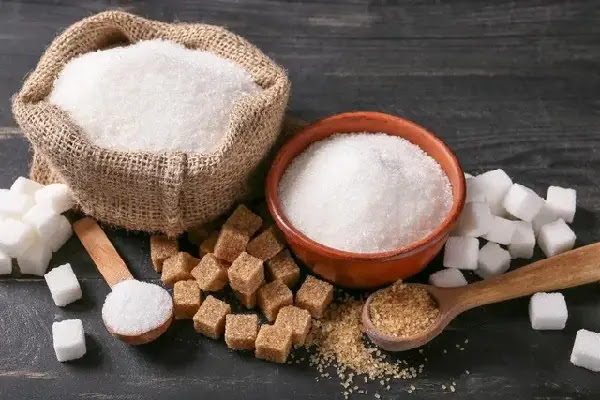In food, the term sugar in lists of ingredients and nutritional values is related to single and double sugars. There are several other sugars in addition to the well-known sugars table sugar, grape, lactose, and fructose. Some of them are only found in a few natural foods and have unique properties.
Table sugar (sugar)
Table sugar (colloquially sugar, sucrose) is a double sugar and consists of equal proportions of fructose (fruit sugar) and glucose (grape sugar). Sucrose causes the blood sugar level to rise sharply and has a 100 (reference) sweetness. The white crystal is obtained from beet and cane sugar. In nature, sugar still occurs in small amounts in fruits and vegetables.
Excessive consumption promotes overweight and obesity, diabetes mellitus, or lipid metabolism disorders. Sugar raises the energy density of food and can lead to a positive energy balance.
Fructose, glucose
The simple sugars fructose and glucose are also found in fruits and vegetables. Fructose does not cause the blood sugar level to rise that much, but it can promote diseases such as fatty liver and metabolic syndrome when consumed in large quantities.
Galactose
In contrast to most sugar siblings, galactose is absorbed independently of insulin. It is also known as "brain sugar" and is used efficiently by the CNS as an energy source.
Lactose and maltose
The double sugar lactose (milk sugar) is contained in milk and milk products and consists of equal proportions of glucose and galactose. Maltose (malt sugar), a compound sugar made up of 2 molecules, causes the blood sugar level to rise the most. The malting of grain mainly causes it.
Trehalose
Trehalose, a simple sugar, occurs naturally in mushrooms and plants. The sweetening power is less than that of sugar. Trehalose is currently suspected of promoting bacterial infections (clostridia) in large quantities in the intestine.
Psicosis (allulose)
Psicose is found in small amounts in fruits. The double sugar, also known as allulose, provides hardly any energy because the intestine only slightly absorbs it. Allulose is not yet approved in the EU. The rare sugar is currently being intensively researched because it has promising properties.
Tagatose
The simple sugar tagatose is found in small amounts in some fruits and processed dairy products. Scientific studies indicate a prebiotic effect of the sugar since it is fermented in the intestinal bacteria's intestine. The low glycemic index is also striking. In nutritional tables, energy content of 400 kcal per 100 grams is given. Studies suggest, however, that the calorific value could only be around 150 kcal per 100 g due to the unique metabolism ( Link ).
Isomaltulose
The double sugar isomaltulose is a natural component of honey. The sugar is not cariogenic and has a very similar table sugar structure. However, the sweetness and glycemic index are significantly lower.
Sugar syrups
Not to be forgotten is the production of so-called sugar
syrups such as glucose, fructose, glucose-fructose syrup, or isoglucose. In terms
of metabolism, these behave like their regular sugar counterparts. Sweetening
power, metabolism, and GI vary depending on the composition of the sugar
contained.
